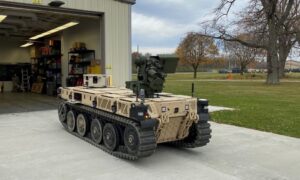While the Army has experimented with both light and medium versions of Robotic Combat Vehicles (RCV), the service’s top acquisition official has confirmed the service plans to move ahead for now with a focus on developing the light variant, the RCV-L.
“The Army is still broadly, of course, interested in robots of many different sizes. But we’re focusing on RCV-L because we think that’s a necessary first step before going to larger platforms,” Doug Bush, assistant secretary of the Army for acquisition, logistics and technology, told reporters on July 27.

Fiscal year 2023 budget request documents had detailed the Army’s intent to pursue a full and open competition starting next year for an RCV-L surrogate and, eventually, full system prototypes, which are intended to build on the current experimentation effort.
The Army in January 2020 awarded an RCV-L prototype deal to QinetiQ and Oshkosh Defense’s [OSK] Pratt Miller to deliver four vehicles for experimental testing based on a variant of the Expeditionary Modular Autonomous Vehicle, with an option to potentially procure 16 additional vehicles (Defense Daily, Jan. 9).
At the same time, the Army also selected Textron [TXT] and its team of Howe & Howe and FLIR [FLIR] to deliver the Ripsaw M5 as the RCV-Medium prototype for evaluation.
General Dynamics [GD] has also shown interest in offering its Tracked Robot X-Ton, or TRX, robotic vehicle for RCV-M, with company officials telling Defense Daily in October of plans to demonstrate the platform to the Army this year following participating in a couple previous experiments (Defense Daily, Oct. 15, 2021).
While Bush affirmed the Army’s plans to defer RCV-M for the time being in favor of developing the RCV-L, he told reporters the service is particularly focused on the software element for robotic platforms to ensure the ability to leverage the technology across a range of platforms.
“From an acquisition standpoint, we’re focused on…, in particular, the software, which will be critical for all ground robotics programs going forward. Getting that right early is going to be essential,” Bush said.
Bush noted the Army has separated out the software elements of RCV into its Software Acquisition Pathway effort “because we want that control software to be common across many robotic platforms.”
The Army has previously detailed its efforts to develop its own autonomy software called robotic technology kernel, or RTK, that was integrated on its RCV-L and RCV-M prototypes (Defense Daily, March 16).
Meanwhile, Bush added that the Army, and Futures Command in particular, continues to work through how RCVs will be integrated with future units and augment tasks carried out by human operators.
“That’s so you understand what a future scout platoon looks like, for example, that might include robots and people. Is that mix different than what we have now? So I think we have a lot to learn on that,” Bush said.